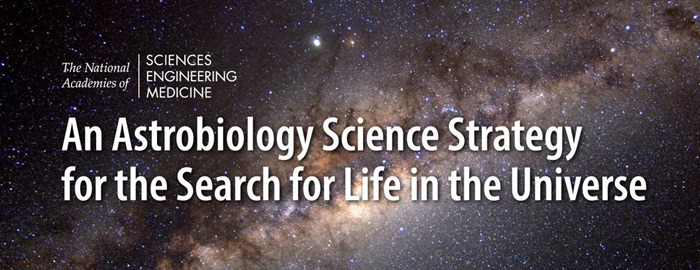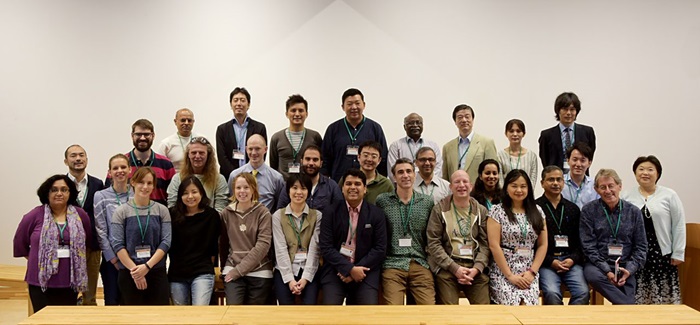
Life Detection Technologies for the Next Two Decades: a Part of the National Academy of Science Astrobiology Science Strategy for the Search for Life in the Universe
The science of the search for extraterrestrial life, often termed astrobiology, is a major thrust in space exploration. While laboratory-oriented astrobiologists are currently exploring plausible ways by which life can emerge on any planet and defining its associated biosignatures, technology-oriented astrobiologists are developing and implementing techniques to detect definite biosignatures. The goal of 'defining' and 'detecting' extraterrestrial biosignatures is trans-disciplinary, including but not limited to chemistry, biology, geology, planetary science, and even engineering, to say the least.
In the fall of 2017, ELSI scientists, led by Chaitanya Giri, Tony Jia, Tomohiro Usui, H. James Cleaves, Hidenori Genda and others, organized an international workshop, including participants from the United States, Japan, India, Germany, and France (among others) to discuss the current state-of-affairs in life detection technologies, the requisites for their further advancement, the practical implications of implementation of future life detection technologies, and to cultivate an international and interdisciplinary community to foster the future progress in this field.

Workshop participants
This workshop led to a white paper titled 'Life Detection Technologies for the Next Two Decades, which was submitted to the Astrobiology Science Strategy for the Search for Life in the Universe program of the National Academies of Sciences, Medicine and Engineering of the United States of America.
The paper begins with highlighting the need to refocus on the foundational questions in astrobiology: what is life? how do we define life? and will life elsewhere be identical or similar to life based on Earth?
The paper then delves into the recent advances in prebiotic chemistry and its role in shaping the technical specifications of the life detection payloads. The authors recommend the pursuing life-detection technologies through the following proof-of-concepts:
1. Avoid over-dependence on plausible prebiotic molecules (synthesized under simulated conditions) as biosignatures, as each is based only on 'known' biochemistries.
2. Biomarkers that have not been synthesized in laboratory-simulated prebiotic environments plausibly should not be assumed to be non-existent in extraterrestrial environment.
3. Earth-based life emerged and evolved in conjunction to the Earth's geochemistry, and it is possible that extraterrestrial life could be composed of chemicals unrelated to modern biochemistry, in conjunction to the geochemistry of the host planetary body, and even made from unknown chemical compounds.
4. Biosignatures must not be taken simply as molecules, but as chemical distributions and networks so as to incorporate abiological, extinct, as well as unknown "biological" signatures.
The authors discussed the technological advancements required for robust, unmanned robotic probes to reach often-inaccessible sites on other planets, collect samples, and either send the samples back to Earth in sample return missions (which requires refurbishment and optimization of Earth-based sample handling techniques) or perform in situ analysis to finally transmit the analytical 'big data' to the Earth.
Coupled in situ visual and spectral detection technologies, through astronomical telescopes, were raised as a very important technological advancement that would be necessary to avoid false positives. Emerging high-power and highly-sensitive astronomical telescopes and remote sensing will not only inform planetary scientists on potentially habitable exploration sites but also determine the instrumental specifications of life detection payloads. Since environmental conditions on various planetary bodies, such as Enceladus or Mars, are dissimilar, the space-probes and the life-detection payloads bound for these bodies in future and the habitable regions within them must be selected carefully. Thus, the workshop organizers curated contributions from participants whose research focuses on novel technologies from non-space-related fields that may be useful for future incorporation into space missions.
These include air sampling of bacteria in Earth's stratosphere with a novel cryogenic payload; novel high-sensitivity fluorescent measurements of cells and membranes; novel simultaneously-coupled nucleic acid, peptide, and small molecule microfluidic sequencing techniques; novel enantioselective chromatography techniques; miniature mass spectrometers coupled with novel machine learning and artificial intelligence techniques for data analysis; and novel synchrotron radiation and magnetic field-based spectrometry and microscopy techniques.
The authors - also the workshop participants - agreed mutually that focusing on research, development, and optimization of life detection technologies is a necessary and significant part of astrobiology's future, which that can only be realized through concerted international and interdisciplinary collaborations. The authors hope to establish an uninhibited-by-governmental-oversight international and interdisciplinary network to forge collaborations in research and development of life detection technologies and data analyses.
This white paper is a part of the National Academy of Sciences Astrobiology Science Strategy for the Search for Life in the Universe report assembled by a the world's foremost astrobiology experts, chaired by the University of Toronto's Barbara Sherwood Lollar. Here are links to the report and articles that discuss the paper and the report"
http://sites.nationalacademies.org/SSB/CurrentProjects/SSB_180812
https://amp.space.com/42086-whats-next-for-astrobiology-at-nasa.html
https://qz.com/1418576/us-scientists-lay-out-plan-to-search-for-life-in-universe/amp/
| Journal | arXiv |
| Title of original paper | Life-Detection Technologies for the Next Two Decades |
| Authors | Chaitanya Giri1,2,*, Tony Z. Jia1, H. James Cleaves II1,3,4,5, Tomohiro Usui1,6, Dhananjay Bodas7, Christopher Carr8,9, Huan Chen1010, Yuka Fujii1, Yoshihiro Furukawa11, Hidenori Genda1, Richard J. Gillams1, Keiko Hamano1, Shingo Kameda12, Ramanarayanan Krishnamurthy13, Cornelia Meinert14, Markus Meringer15, Kishore Paknikar7, Sudha Rajamani16, Sisinthy Shivaji17, Andrew Steele2, Masateru Taniguchi18, Hikaru Yabuta19, Akihiko Yamagishi20 |
| Affiliations | 1. Earth-Life Science Institute, Tokyo Institute of Technology 2. Geophysical Laboratory, Carnegie Institution for Science 3. Blue Marble Space Institute of Science 4. Center for Chemical Evolution, Georgia Institute of Technology 5. Institute for Advanced Study 6. Department of Earth and Planetary Sciences, Tokyo Institute of Technology 7. Nanobioscience Group, Agharkar Research Institute 8. Earth, Atmospheric and Planetary Science, Massachusetts Institute of Technology 9. Department of Molecular Biology 10. National High Magnetic Field Laboratory, 11. Department of Earth Science, Tohoku University 12. Department of Physics, Rikkyo University 13. Department of Chemistry, The Scripps Research Institute 14. Université Côte d'Azur, CNRS, Institut de Chimie de Nice UMR 15. German Aerospace Center (DLR), Earth Observation Center (EOC) 16. Indian Institute for Science Education and Research (IISER) 17. LV Prasad Eye Institute 18. The Institute of Scientific and Industrial Research, Osaka University 19. Department of Earth and Planetary Systems Science, Hiroshima University 20. Department of Applied Life Sciences, Tokyo University of Pharmacy and Life Sciences |
| Link | arXiv:1810.06026 |
| Online published date | October 14, 2018 |
